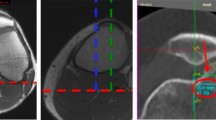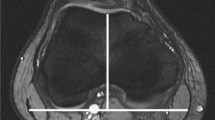Abstract
Background
Accurate planning for patellar instability correction is important in obtaining good post-operative outcome. The main challenge in the current two-dimensional (2-D) computed tomographic (CT) scans method is the difficulty in choosing reliable bony landmarks. This study aimed to compare the reliabilities between the 2-D and three-dimensional (3-D) methods of measuring tibial tubercle–trochlear groove (TT–TG) distance. We hypothesize that the proposed 3-D method will result in measurements with narrower error margin, providing higher reliability and accuracy.
Materials and Methods
We traced CT scans of 106 knees with no patellofemoral pathology from 59 subjects from the database system and converted all 2-D images into 3-D models to determine the values for each parameter. We compared the intra- and interobserver reliability of each method using intraclass correlation (ICC) and Bland–Altman method.
Results
The values of TT–TG measured by 2-D and 3-D methods were 16.1 ± 4.6 mm and 16.2 ± 4.2 mm, respectively. The ICC values of both methods were comparable (95% limits of agreement between the same observer: − 3.3 to 3.8 mm versus − 2.4 to 2.7 mm and different observers: − 4.3 to 4.9 mm versus − 3.9 to 2.7 mm), with 3-D method results in narrower limits of agreement.
Conclusion
TT–TG measurement is reliable using the 2-D method without using advanced radiographic software. The 3-D method of measuring TT–TG provides measurement with narrower variation when compared with the 2-D method. However, both TT–TG distances’ measurement methods in the current study were comparable as the variations are not significant.
Graphical Abstract





Similar content being viewed by others
Data availability
Research data and materials are available upon request to the corresponding author.
References
Hall, M. J., & Mandalia, V. I. (2016). Tibial tubercle osteotomy for patello-femoral joint disorders. Knee Surgery, Sports Traumatology, Arthroscopy, 24, 855–861.
Kuroda, R., Kambic, H., Valdevit, A., & Andrish, J. T. (2001). Articular cartilage contact pressure after tibial tuberosity transfer: A cadaveric study. American Journal of Sports Medicine, 29, 403–409.
Sanders, T. L., Pareek, A., Johnson, N. R., Stuart, M. J., Dahm, D. L., & Krych, A. J. (2017). Patellofemoral arthritis after lateral patellar dislocation: A matched population-based analysis. American Journal of Sports Medicine, 45, 1012–1017.
Carney, J. R., Mologne, T. S., Muldoon, M., & Cox, J. S. (2005). Long-term evaluation of the Roux-Elmslie-Trillat procedure for patellar instability. American Journal of Knee Surgery, 33, 1220–1223.
Dejour, H., Walch, G., Nove-Josserand, L., & Guier, C. (1994). Factors of patellar instability: An anatomic radiographic study. Knee Surgery, Sports Traumatology, Arthroscopy, 2, 19–26.
Koëter, S., Horstmann, W. G., Wagenaar, F.-C.B.M., Huysse, W., Wymenga, A. B., & Anderson, P. G. (2007). A new CT scan method for measuring the tibial tubercle–trochlear groove distance in patellar instability. The Knee, 14, 128–132.
Camathias, C., Pagenstert, G., Stutz, U., Barg, A., Müller-Gerbl, M., & Nowakowski, A. M. (2016). The effect of knee flexion and rotation on the tibial tuberosity–trochlear groove distance. Knee Surgery, Sports Traumatology, Arthroscopy, 24, 2811–2817.
Lustig, S., Servien, E., Selmi, T. A. S., & Neyret, P. (2006). Factors affecting reliability of TT–TG measurements before and after medialization: A CT-scan study. Revue de Chirurgie Orthopedique et Reparatrice de l’Appareil Moteur, 92, 429–436.
Lamraski, G., Monsaert, A., De Maeseneer, M., & Haentjens, P. (2006). Reliability and validity of plain radiographs to assess angulation of small finger metacarpal neck fractures: Human cadaveric study. Journal of Orthopaedic Research, 24, 37–45.
Shrout, P. E., & Fleiss, J. L. (1979). Intraclass correlations: Uses in assessing rater reliability. Psychological Bulletin, 86, 420–428.
Bland, J. M., & Altman, D. (1986). Statistical methods for assessing agreement between two methods of clinical measurement. Lancet, 27, 307–310.
Iranpour, F., Merican, A. M., Baena, F. R. Y., Cobb, J. P., & Amis, A. A. (2010). Patellofemoral joint kinematics: The circular path of the patella around the trochlear axis. Journal of Orthopaedic Research, 28, 589–594.
Iranpour, F., Merican, A. M., Dandachli, W., Amis, A. A., & Cobb, J. P. (2010). The geometry of the trochlear groove. Clinical Orthopaedics and Related Research, 468, 782–788.
Victor, J., Van Doninck, D., Labey, L., Innocenti, B., Parizel, P. M., & Bellemans, J. (2009). How precise can bony landmarks be determined on a CT scan of the knee? The Knee, 16, 358–365.
Wagenaar, F. C., Koëter, S., Anderson, P. G., & Wymenga, A. B. (2007). Conventional radiography cannot replace CT scanning in detecting tibial tubercle lateralisation. The Knee, 14, 51–54.
Aarvold, A., Pope, A., Sakthivel, V. K., & Ayer, R. V. (2014). MRI performed on dedicated knee coils is inaccurate for the measurement of tibial tubercle–trochlear groove distance. Skeletal Radiology, 43, 345–349.
Wadhwa, V., Malhotra, V., Xi, Y., Nordeck, S., Coyner, K., & Chhabra, A. (2016). Bone and joint modeling from 3D knee MRI: Feasibility and comparison with radiographs and 2D MRI. Clinical Imaging, 40, 765–768.
Kulkarni, S., Shetty, A. P., Alva, K. K., Talekar, S., & Shetty, V. D. (2016). Patellar instability in Indian population: Relevance of tibial tuberosity and trochlear groove distance. SICOT J, 2, 14–17.
Mo, K. M., Cho, K. Y., Au, K. Y., Lee, K. Y., & Cheng, H. M. (2020). Establishing the reference value for tibial tubercle-trochlear groove distance on MRI in Southern Chinese population and its correlation with age, sex, height, weight and size: A multi-centre study. J Orthop Trauma Rehabil. https://doi.org/10.1177/2210491720969706
Acknowledgements
We would like to thank Mr. Mohd Rashdan Abd Rahim for the writing assistance during the submission process.
Funding
This project is not supported by any fund.
Author information
Authors and Affiliations
Contributions
Conceived and designed the experiments: SHT, TKO, AMM, MSH, WMN, MZMA, and MRMA. Analyzed the data: SHT, TKO, and MSH. Writing the manuscript: SHT, TKO, and MSH. Jointly developed the structure and arguments for the paper: SHT, TKO, AMM, MSH, WMN, MZMA, and MRMA. All authors reviewed and approved the final manuscript.
Corresponding author
Ethics declarations
Conflict of Interest
All authors declare that there are no conflicting interests.
Ethical Approval
This article does not contain any studies with human participants or animals performed by any of the authors.
Informed Consent
This study is a retrospective data research and does not involve patient intervention. Thus, no individually informed consent is required.
Additional information
Publisher's Note
Springer Nature remains neutral with regard to jurisdictional claims in published maps and institutional affiliations.
Rights and permissions
Springer Nature or its licensor (e.g. a society or other partner) holds exclusive rights to this article under a publishing agreement with the author(s) or other rightsholder(s); author self-archiving of the accepted manuscript version of this article is solely governed by the terms of such publishing agreement and applicable law.
About this article
Cite this article
Teo, S.H., Ong, T.K., Merican, A.M. et al. Are Two- and Three-Dimensional Computed Tomographic Scan Measurements of Tibial Tubercle–Trochlear Groove Distance Equivalent? A Comparative Study. JOIO 57, 847–855 (2023). https://doi.org/10.1007/s43465-023-00874-x
Received:
Accepted:
Published:
Issue Date:
DOI: https://doi.org/10.1007/s43465-023-00874-x




